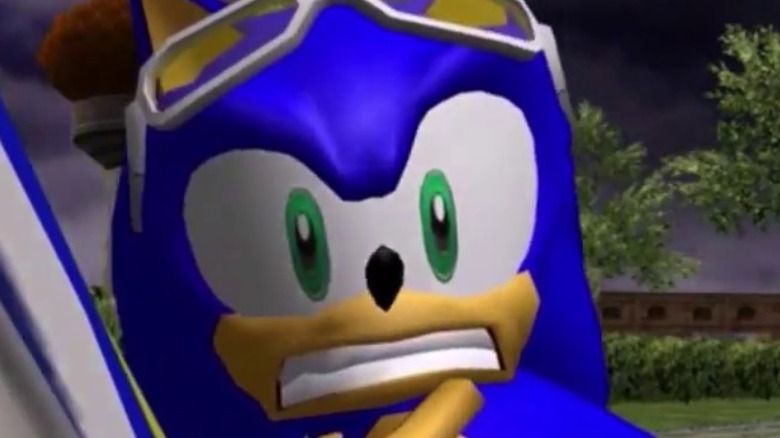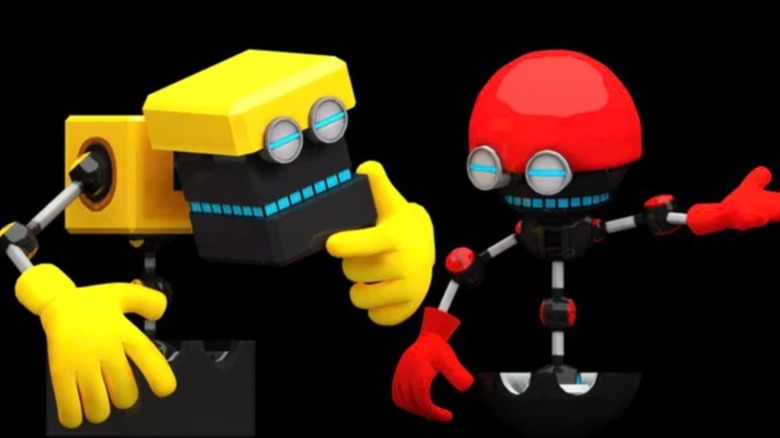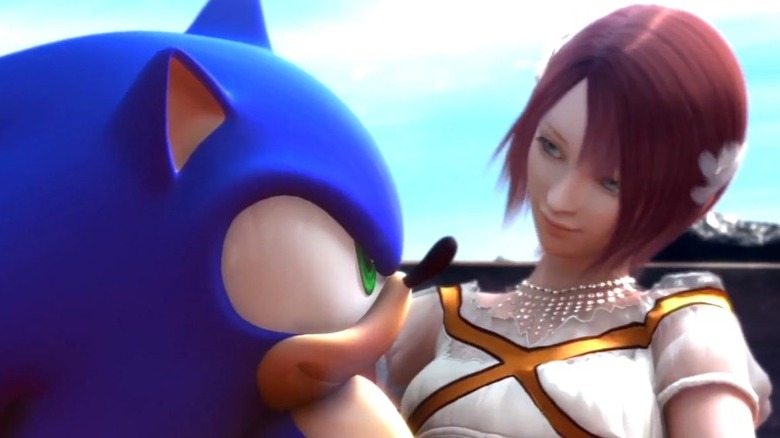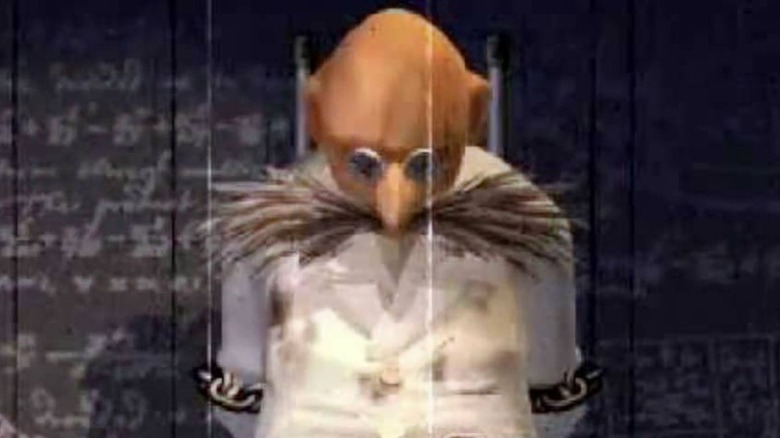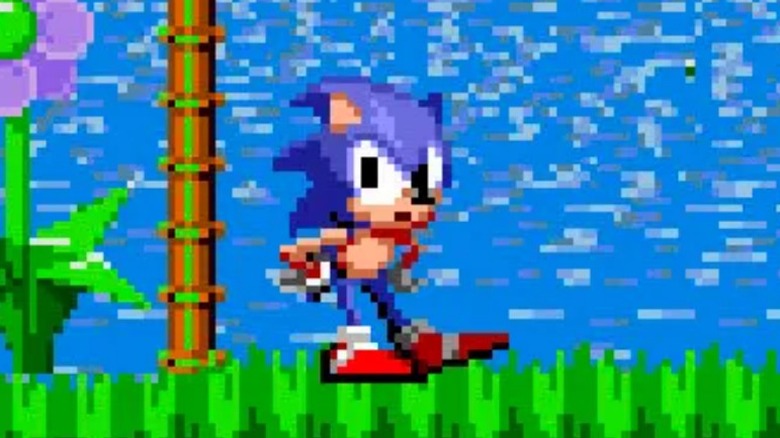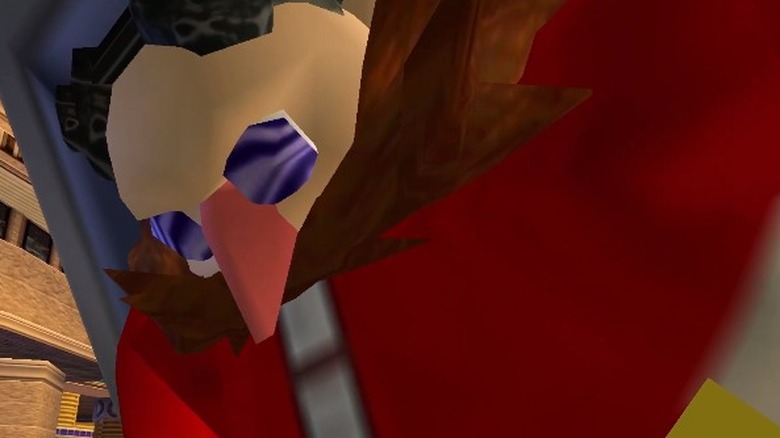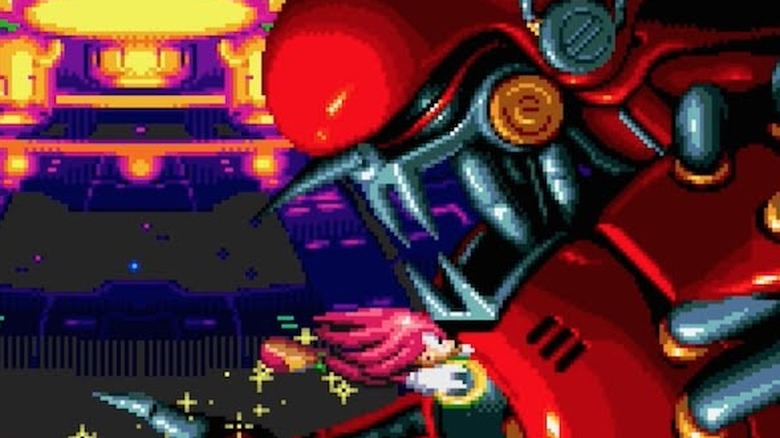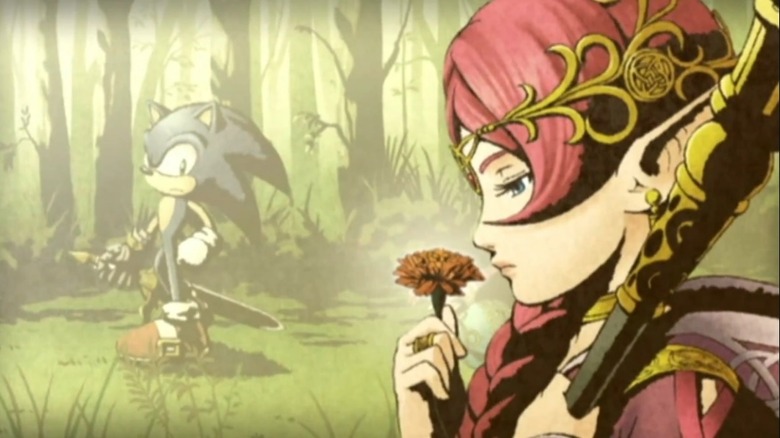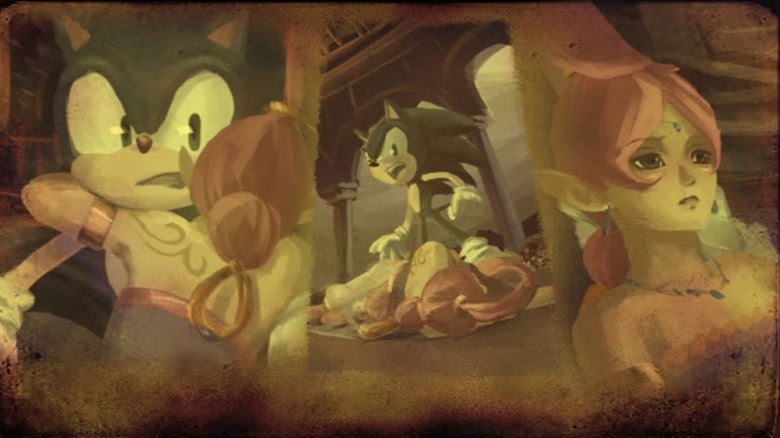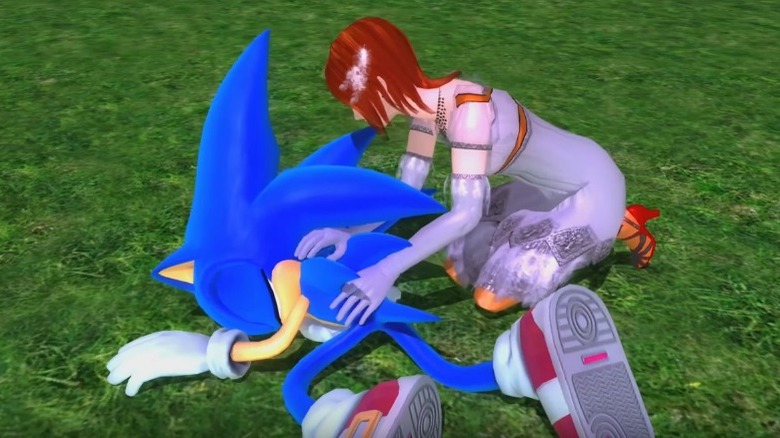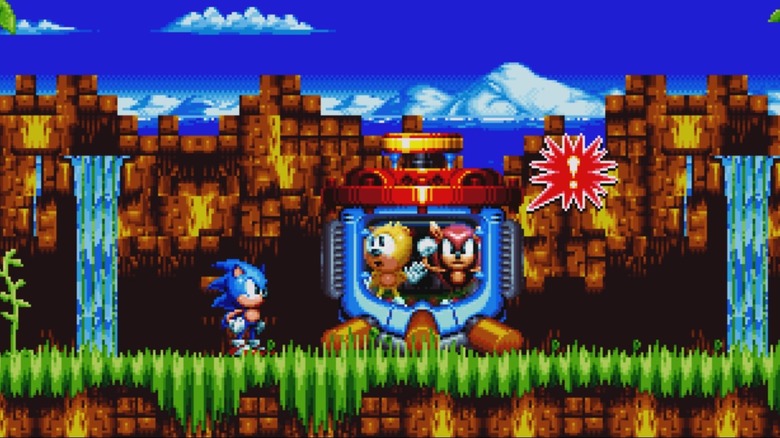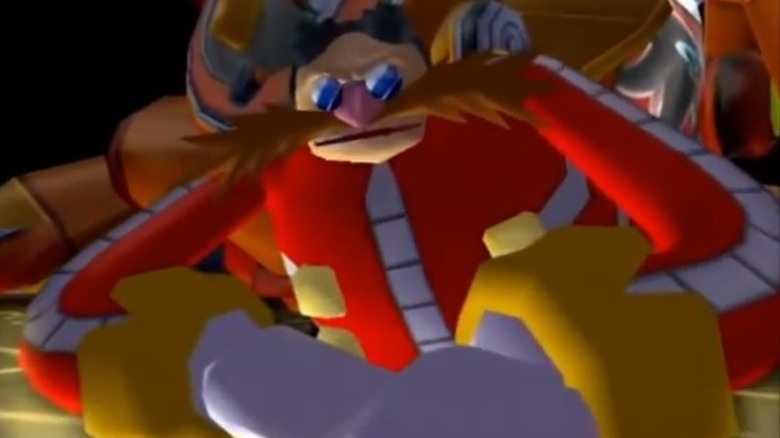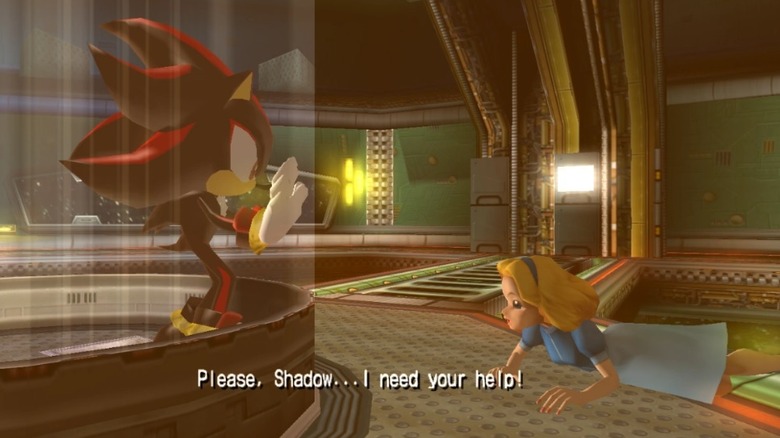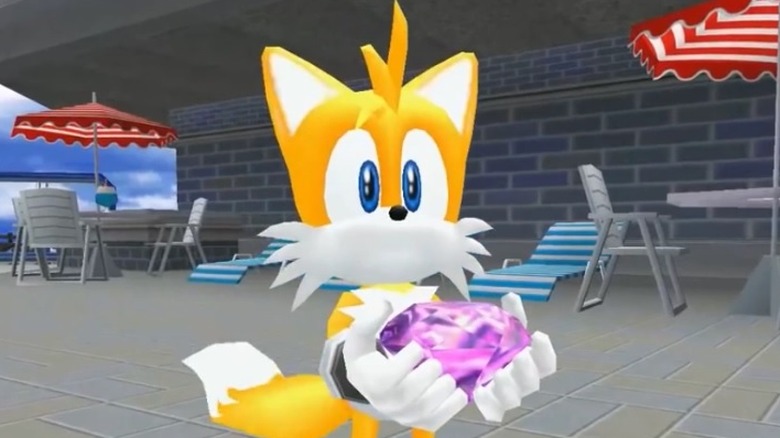The Most Messed Up Things In Sonic Games
We may receive a commission on purchases made from links.
"Sonic the Hedgehog" isn't a series solely about fun and (video) games — it's also about darkness, death, and existential dread. Sonic's long lineage of games features many instances of themes almost exclusively suited for adult storytelling. Yet, no matter how mature or messed up the content is, it has somehow managed to sneak its way into a franchise about a blue cartoon hedgehog who runs fast. Because, in case you thought Sonic was just a happy-go-lucky fellow who ran around collecting rings, we're here to remind you he's also a cautionary tale on why not to enslave animals or date women who aren't over their last boyfriend.
Most of these wild instances of off-brand intensity occur in the some of the later "Sonic" titles, since those were the ones that started promoting big, dramatic stories. With that said, we've got something from every era of Sonic on here, because the blue blur's never been totally kid-friendly. Get ready for a trip down memory lane as we revisit the highlights of Sonic and co.'s most messed up moments.
Eggman abandons his henchmen
Like all good villains, Dr. Eggman doesn't work alone. He has a variety of henchmen who have assisted him in his various schemes over the years, aiding him in carrying out his dastardly plans. Two of his most trusted servants are two small robots named Orbot and Cubot. They made their first appearance together in "Sonic Colors" and have become so well known in the series that they even have their very own action figures.
While these robotic figures are undoubtedly loyal to their master, even if they do have somewhat sarcastic personalities, the same is not true of Eggman himself. Orbot and Cubot have always done as they are told, but the villain has shown that he is not loyal to his henchmen. In fact, he even abandoned them in space with seemingly no way to get home safely.
In "Sonic Colors," the pair are pushing Eggman through space in his damaged craft when they come across the Time Eater. Knowing that this is his chance to get home, he gets the two robots to push him into the Time Eater and disappears in front of them. By the time of "Sonic Generations," it is revealed that Eggman left both Orbot and Cubot behind and made no attempt to rescue them.
Lots of interspecies romance
Like any form of mediam, it is not unusual in video games to feature romance elements. In fact, it's a common element in stories for the hero to have some sort of love interest who can provide extra motivation. Perhaps they might have to rescue them in a classic "damsel in distress" scenario, or they are a valuable ally who can help the protagonist on their quest.
In that respect, the "Sonic the Hedgehog" series is no different. Sonic himself has had a lot of love interests over the years. However, there is a slight problem in that many of the relationships in the franchise have been between the various animals who make up the main characters and humans. Although the likes of Sonics, Tails, and Knuckles are sentient, they are decidedly not human.
Perhaps the most notable example of this type of relationship was in 2006's "Sonic the Hedgehog," when Princess Elise kisses Sonic. But there are also other notable instances of this phenomenon, such as Sonic's previous girlfriend Madonna. Speaking to IGN, senior game designer Takashi Iizuka acknowledged the issue and the fan backlash, suggesting that Sega would be avoiding interspecies romance in the future.
Gerald Robotnik's creepy execution
Although he bears a striking resemblance to the main villain from the "Sonic the Hedgehog" series, Professor Gerald Robotnik is not actually the Dr. Eggman fans know. Instead, he is the grandfather of the infamous bad guy and, as leader of Project Shadow, the creator of Shadow the Hedgehog. He would later lose his mind and was ultimately imprisoned after threatening to destroy all of humanity to avenge the death of his granddaughter, who had been killed by the military while helping Shadow escape the ARK Space Colony.
His final moments can be seen in "Sonic Adventure 2" when a videotape is played, which shows a tied up Robotnik giving a final speech before he is executed. The rambling monologue explains how he will get revenge by wiping out the entire population. He notably sounds deranged and doesn't seem to understand exactly the gravity of the situation. The video cuts out as a soldier seemingly signals his troops to finish Robotnik off, although this gruesome scene is thankfully not displayed.
Sonic gets WAY too bored
A whole host of video games have featured interesting easter eggs that trigger when the player is idle for an extended period of time. These typically feature the playable character doing something that they ordinarily wouldn't, rather than simply standing still forever. Earthworm Jim, for instance, had a number of unique animations that involved everything from skipping with his own head to singing opera, while Conker from "Conker's Bad Fur Day" would pull out a Game Boy and start playing his own game.
So it makes sense that the "Sonic" series would also have these sorts of idle animations as they are such a staple of video games in general. The only problem is that one of them is pretty jarring and kind of in poor taste.
In "Sonic CD," Sonic will decide he's had enough of waiting for the player, since letting the timer run out is a death sentence on its own. If left idle for too long, Sonic will announce "I'm outta here" before jumping off the screen, prompting a "game over" to pop up — a somewhat questionable joke to make.
Eggman's desperate attack
First released in 1998, "Sonic Adventure" is a platform game that features several different storylines following beloved long-running characters such as Sonic, Knuckles, Amy Rose, and Tails. The overarching plot sees Dr. Eggman trying to unleash an ancient god known as Chaos on the world by collecting the Chaos Emeralds.
After being defeated by Sonic, Eggman falls into the heavily populated city known as Station Square — a location filled with skyscrapers, amusement parks, and family homes. When it appears as if all hope is lost for the villain, he launches a nuclear missile in the full knowledge that its explosion would not only kill millions of innocent people, but also take himself out. And yet, Eggman appears to completely accept this fate and see it as a reasonable reaction to what has happened.
The missile lands without exploding, prompting both Eggman and Tails to race towards it. Tails ultimately arrives first and prevents it from being detonated remotely, then turns his attention to Eggman, who finds his second wind and continues the battle.
The horrifying bad ending of Knuckles' Chaotix
"Knuckles' Chaotix" is a 1995 spin-off game that features Knuckles the Echidna as the main hero. The story sees Knuckles attempting to put a stop to Dr. Robotnik's schemes, who aims to use Metal Sonic to collect six magic rings that would allow him to take over a mysterious island. Like other games in the series, "Chaotix" is a side-scrolling platformer, although the player is forced to work with other characters to whom they are tethered in order to navigate through the stages.
Where "Knuckles' Chaotix" takes a turn is right at the very end. If the player fails to collect all of the Chaos Rings before beating the final boss, they will only get the bad ending of the game. Usually, bad endings like this paint things in a slightly worse light, reminding the player that they may have saved the day, but they were not entirely successful. This game went one step further by seemingly showing the entire destruction of a city.
As the credits roll, a giant Metal Sonic Kai hovers overhead as the world burns below, with the entire thing accompanied by very ominous music. It just seems so completely out of place and hopeless for any "Sonic" game.
Merlina's existential dread
"The problem of being faster than light is that you can only live in darkness" is a quote that aptly sums up Sonic's experience in "Sonic and the Black Knight," a game in which the blue hedgehog is forced to outrun the existential dread that consumes his companion.
Towards the end of the game, Sonic's lady friend Merlina reveals herself unable to cope with the reality that all things die. Due to the grief this fact causes her, she becomes the game's secret twist villain, bent on using black magic to make a medieval kingdom (the game is set in Arthurian times, if you couldn't guess from the name) that lives on forever, free of death and deterioration.
To this, Sonic argues that the beauty of life is in making the most of the time you have. When Merlina won't listen to him, though, Sonic tries to stop her (though his attempts are mild and simply meant to pacify). Merlina ruthlessly beats him until he's bruised and broken. The whole scene is just painful to watch, filled with dreary existentialism and harsh violence for a "Sonic" game.
Infidelity and literal heartburn
"Sonic and the Black Knight" isn't the only thematically-loaded game in the "Sonic Storybook" series — there's also the original entry in the spinoff brand: "Sonic and the Secret Rings." Just like "Black Knight," "Secret Rings" makes sure it does its fabled setting justice by having a particularly heavy plot, keeping it in line with older mythology's tendency to pack a harder punch than much modern fiction.
The plot is centered around Sonic having a flame in his chest that's continually shrinking and, once it burns out, he dies. This curse is cast by an evil genie who demands Sonic find him the seven World Rings in exchange for the removal of the spell. With the help of a good genie named Shahra, Sonic collects the rings. However, at the end of the game, it's revealed the evil genie isn't going to fix the curse and, worse yet, that Shahra's been in cahoots with him the whole time because she has the hots for him. In other words, Sonic is sentenced to die of literal heartburn while also getting screwed over and cheated on by his sort-of-girlfriend genie companion. It's a tough break, to say the least.
Mind you, the plot's finale gets even wilder from there, so definitely play the game if you want to experience one of Sonic's most fun and uniquely intense games firsthand.
The death of Sonic the Hedgehog
If you ever wanted to see a villain succeed in killing Sonic the Hedgehog, "Sonic '06" is the game for you. The kicker is, it's not even Dr. Eggman who does the deed. It's the new bad guy on the block, Mephiles, who succeeds in lethally energy-spearing Sonic through the chest.
It's not even a fight. Mephiles ambushes Sonic from behind while the latter is taking a walk in the park with his girlfriend. There's no honor or dramatic struggle involved, just a one-hit cheapshot from the back. What makes this whole scene even sadder is that Sonic's just collateral damage; Mephiles doesn't even care about defeating the hedgehog for personal reasons. All the villain wants is to make Sonic's girlfriend cry because of some voodoo magic locked away within her tears, and Sonic's death happens to be the easiest way to break her.
The whole plot point of Sonic's death is just relentlessly dark and sad in every aspect. It's essentially "Batman v Superman: Dawn of Justice" transmuted into a story about anthropomorphic hedgehogs and frail human princesses.
Animal enslavement
Ever since Sonic's 1991 debut, the speedy blue hedgehog has had to contend with one of the most messed up things in all of gaming: a villain who is obsessed with capturing, enslaving, and harvesting the life energy of little woodland critters. You can see this in numerous Sonic games, including the classic "Sonic the Hedgehog." Whenever Sonic destroys a badnik, a little animal hops out. And, at the end of levels, Sonic has to hop on top of portable prison cells to free more animals. All of these entrapped creatures are the result of Dr. Eggman's obsession with hurting wildlife. Plus, he constantly deforests their homes and destroys their biomes to build mechanical, pollution-creating factories.
Eggman's not even doing all of this in the service of a big endgame, like wanting to create a purely artificial world — if that were the case, he wouldn't rely on tiny animals to power his sinister creations. No, this is the mindset of a villain that just likes to hurt defenseless creatures because it's easy. If that's not messed up, nothing is.
Shadow scrambles the Eggman
In a strange way, killing the main villain of a franchise is quite similar to killing the main hero — it's an extreme rarity that always draws gasps from audiences. After all, Batman and Joker, Superman and Lex, Spider-Man and Green Goblin — guys like these are built to tussle for eternity. The only times a villain with this kind of stature actually dies is usually in a spin-off story, and even then, it leaves a mark on fans.
Such is the case with "Shadow the Hedgehog," the darker spin-off game with multiple edgy endings — a few of which include Shadow's murder of the main franchise's primary villain, Dr. Eggman. The game features "hero," "neutral," and "evil" choices in every level, and depending on what combination of these you choose across the campaign, different finales will see Shadow the Hedgehog put the nail in Eggman's coffin. Though the game's cutscenes neglect to show the finishing blow in its entirety, it's heavily insinuated that Shadow karate-chops the not-so-good doctor's skull open, leaving him as little more than a scrambled egg.
Maria's murder
In case the assassination of Sonic himself wasn't enough to mess you up, there's always murder of a young girl in the "Shadow the Hedgehog" spin-off to make you feel strange while playing a "Sonic" game.
Shadow the Hedgehog's entire character is defined by the death of this girl, as she was his best friend. Her name was Maria and she, along with Shadow, lived in a space colony run by Dr. Eggman's grandfather, Gerald Robotnik.
Though it's heavily alluded to in "Sonic Adventure 2," Maria's actual death only really gets a spotlight in "Shadow the Hedgehog," when armed soldiers are seen cornering her seconds before she makes sure Shadow escapes the colony safely via a shuttle. Because the soldiers are tasked with killing Shadow (since he was one of Gerald's many problematic science projects aboard the space colony), they kill Maria to try to stop her from rescuing him. And Shadow has to watch this all from within his escape pod, unable to help the only person he cares about.
The fracturing of Earth
In "Sonic Unleashed," Eggman summons a monster from within the earth's core and splits the world apart to give said monster room to breathe. This involves tearing the earth's crust into massive, continent-encompassing puzzle pieces. Though that's obviously a "bad" thing, "Sonic Unleashed" never really explores the matter any further.
This begs the earth-shattering question (see what we did there?): What happened to the earth's water supply and the millions of people who were living along the fault lines? Did the majority of the world's oceans drain and evaporate into the center of the earth? How many millions, if not billions, of lives were lost when the earth split and entire cities fell into the planet's molten core? Sonic Unleashed never tidies up these morbid plot holes, leaving us to wonder just how much damage Eggman really did.
Everyone likes to think of him as a goofy, mildly endearing caricature of "evil," but we figure that's only because they're not thinking about the time he drained most of earth's water supply while also instantaneously murdering a sizeable chunk of the world's population.
Tails' inappropriate timing
There's a reason (almost) no one likes Tails. It's not because he ruined every special stage in "Sonic the Hedgehog 2." It's not because of his pitiable, defenseless nature. It's because of the nonsense he spouts at the worst possible times. Case in point: the bookend cutscene of "Sonic Adventure."
After Super Sonic and Perfect Chaos go toe to toe, the city they do battle in is left in ruin. Station Square is flooded to a degree that makes Hurricane Katrina look mild, and it goes without saying that countless civilians die (off camera) during the proceedings. Thousands, if not millions, drown to death, and we're not even discussing the billions in property damage. Though Sonic defeats the monster, the cost is astronomically high.
It's pretty messed up, then, that after all of that death and destruction, Tails sees fit to unironically say, "All's well that ends well, right?" in his perfectly chirpy, childish voice. No, Tails, when there are countless deceased human bodies floating through a flooded city, and everyone still alive is now homeless, that's not the time to say things ended well.

